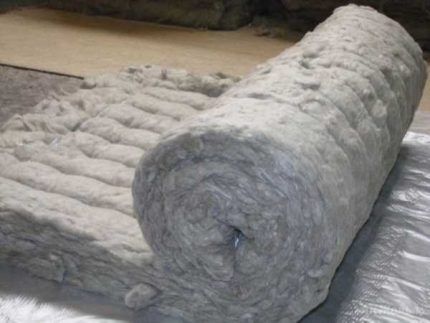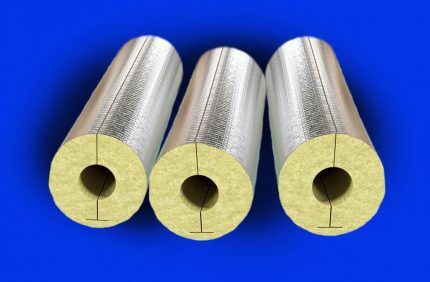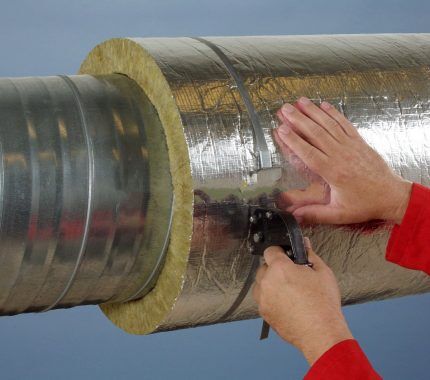Insulation for a gas chimney: thermal insulation options and technology for insulating chimneys
Have you decided to insulate your chimney but can’t choose a thermal insulation material? We will tell you which insulation for a gas chimney will work most effectively in various conditions. Let's consider the types of thermal insulation and dwell in detail on their technical characteristics.
To choose the most optimal option, we will first get acquainted with the designs of chimneys and the materials that are used for their construction. This will help us in choosing thermal insulation protection, which will increase the efficiency of the gas boiler and ensure maximum service life of the chimney.
Our proposed article provides rules for carrying out insulation work. Our recommendations will help you decide on the most rational, simple and easy-to-implement option. The information presented will be extremely useful for independent craftsmen.
The content of the article:
Why insulate the chimney of a gas boiler
When passing through the boiler pipe, heated gases lose temperature, giving up part of their own heat to the walls of the structure. But at the same time, the gas must be vented outside.
The quality of draft largely depends on the temperature of the chimney pipe walls. If there is insufficient draft, there is a risk of smoke in the room and even poisoning from waste combustion products.
The efficiency of removal of combustion products, in other words, the quality of draft, depends on the speed of overcoming the moment of condensation formation. This indicator is largely determined by the material from which it is made. chimney pipe.
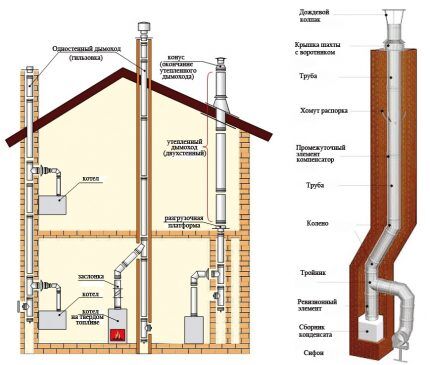
If a stainless or galvanized steel pipe is used as a chimney, then the period of condensation formation takes place within 2-3 minutes, but a standard brick chimney needs much more time - about half an hour.
At the moment condensation appears and until it disappears, active mixing of water with combustion products occurs, and as a result of the ongoing reaction, an acidic solution appears. It is this acid that has a negative effect on the pipe, causing its destruction.
If an asbestos pipe or brickwork is used as a chimney, then condensation residues can be absorbed into their walls. In the absence of high-quality insulation, accumulated moisture will freeze and destroy the chimney. Advantages of chimney insulation
If you properly insulate the chimney pipe from a gas boiler, you can identify a considerable number of advantages. The main ones are:
- Reducing the influence of precipitation;
- Reducing heat loss during the heating season;
- Improved traction quality;
- Presentable appearance of the chimney;
- Reducing the volume of condensate formed on the outside of the chimney pipe.
Taking into account the above advantages, it is obvious that insulating the gas boiler pipe is simply necessary. To carry out the work, various insulation materials can be used, each of which differs not only in physical characteristics, but also in the characteristics of the work.
Rules for installing chimney systems
Before moving on to a review of insulation materials and the rules for working with them, you need to understand the requirements that must be met when installing a chimney. This point is very important, since violation of the standards can lead to the inability to operate the equipment.
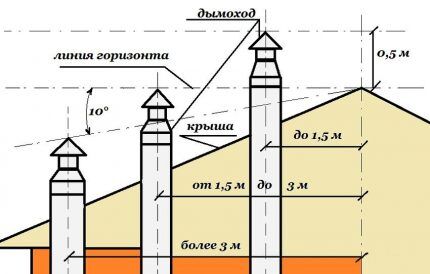
Chimney ducts must comply with the requirements of DBN V.2.5-20-2001 and SNiP 2.04.05-91. The basic requirements are as follows:
- The internal diameter of the chimney pipe must be larger than the diameter of the outlet pipe of the gas boiler;
- The main pipe cannot have curved or tapering sections, must be located vertically, a slope of no more than 30 degrees is allowed;
- The diversion main can have no more than three turns;
- The distance from the outer surface of the pipe to walls made of combustible materials is 25 cm, to walls made of non-combustible materials – 5 cm;
- The insulation of the connections of the chimney elements must ensure complete tightness of the joint;
- No connections are allowed within the roof passage (this part of the chimney pipe must be solid);
- In places of turns, inspection hatches must be installed;
- Bottom part chimney pipe must be equipped with a structure for collecting condensate;
- The upper part should rise above the roof ridge by no less than 50 cm, and the length of the chimney itself should provide high-quality draft.
Compliance with the standards and requirements for the installation of gas chimneys not only improves the operating efficiency of the equipment, extends the service life of the chimney, but also guarantees fire safety and eliminates the threat of smoke in the room.
Types of gas flues
Depending on the material used, gas chimneys are divided into several types, while brickwork is practically not used for gas removal.
However, brick is often used for piping the exhaust pipeline. This is not a simple facing brick - it has a square shape, and its inner part has a round cross-section.
Stainless steel chimney pipes
Metal chimneys are the most popular. The most commonly used material is stainless steel, which is characterized by high corrosion resistance.
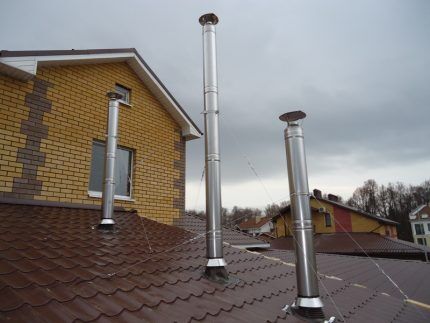
The main advantages of stainless steel structures:
- Resistance to condensed moisture;
- Resistance to precipitation;
- Chemical resistance to soot resulting from gas combustion;
- Resistant to high temperatures;
- The internal smooth surface reduces the coefficient of friction, ensuring the unhindered passage of gases with minimal soot deposition;
- Light weight allows the use of standard fasteners;
- Simple installation eliminates the difficulty of carrying out work with significant destruction of walls;
- Quite affordable price.
It is not recommended to use conventional stainless steel pipes. This is due to the fact that chimney pipes are made of special grades of stainless steel, which, due to the introduction of alloying elements, are highly resistant to acids resulting from the formation of condensate.
Brick chimney installation
Currently, a brick chimney is used much less frequently, because... built mainly for brick kilns, and they are actively being replaced by gas models.In addition, it takes a lot of time to set it up.
Along with this, a brick chimney has the following disadvantages:
- Rough internal surface, promoting the accumulation of soot and reducing traction;
- Instability to corrosion by acid. Due to the hygroscopicity of the material, condensation is absorbed and quickly destroyed;
- Difficulty of construction. Masonry from piece building materials takes much more time than assembling metal or ceramic modules.
The negative qualities of a brick chimney can be eliminated by inserting a sleeve in the form of an asbestos or stainless steel pipe.
Chimney made of asbestos cement pipes
Previously, asbestos-cement pipes were very widely used in the construction of chimneys for gas boilers. Despite the porosity of the material, the roughness of the internal walls and the far from ideal cross-section, the popularity of asbestos-cement pipes is due to their low cost.

To avoid these disadvantages, a chimney made of asbestos-cement pipes should be as straight as possible with sealed joints. Simple cement mortar is not enough here; dried joints must be treated with sealant or special sealed clamps must be used.
In general, the work is not difficult. If the joints are properly sealed, a chimney made from asbestos-cement pipes will be in no way inferior to its stainless steel counterpart. However, during active use it will serve no more than 3-5 years, after which it requires mandatory replacement.
Smoke channel made of ceramic pipes
Chimneys made from ceramic pipes are reliable, durable, and highly corrosion resistant to aggressive substances and temperature changes.
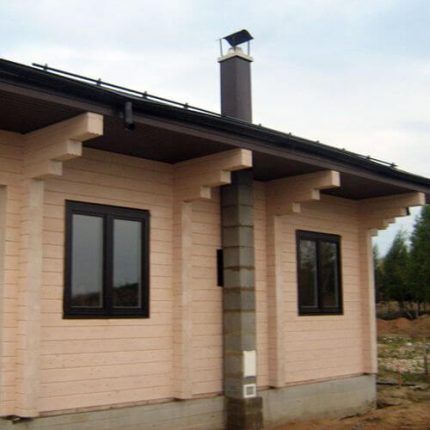
However, along with this, they have their drawbacks - heavy weight, the mandatory construction of a separate foundation and high cost. But all these shortcomings ceramic chimneys covered by decades of reliable and stable operation.
Types of insulation for chimney pipes
The choice of insulation for gas chimneys is quite limited due to high requirements for heat resistance and fire safety.
Obviously, popular sheet foam, polystyrene foam and similar polymers will not work. When exposed to high temperatures, they can not only easily deform, but also ignite if a spark hits them.
Insulation for a gas chimney must meet the following requirements:
- The minimum thermal conductivity index that ensures fire safety standards;
- Light weight to reduce roof load;
- Plasticity and flexibility for simple thermal insulation of geometrically complex areas;
- Neutrality to chemical media, precipitation and condensation;
- Long service life.
The ideal option is to insulate the chimney of a gas boiler using mineral heat insulators. Due to their low cost, previously, bulk materials were most often used, but they lost their position due to low efficiency and large mass.
They gave way to cotton wool insulation, made from basalt wool minerals and fiberglass.These materials are characterized by high fire resistance; they can withstand temperatures of more than 400 degrees.
Mineral wool group
The mineral wool class includes materials: slag fiber, glass fiber, stone wool. Each of the three groups differs in its structure - the thickness and length of the fibers, resistance to stress, moisture resistance and fire safety.
To understand the technical characteristics of mineral wool, we will consider each of the groups separately.
Technical characteristics of glass wool
The thickness of glass wool fibers is in the range of 5-15 microns with a length of 15-50 mm. It is elastic and durable; you need to work with the material as carefully as possible, since glass fibers can not only dig into the skin, but also get into the respiratory tract.
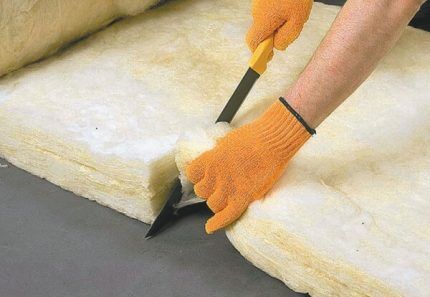
Glass wool has average hygroscopicity, the maximum heating temperature is 450°C. The thermal conductivity coefficient is 0.03 – 0.052 watts per meter per Kelvin.
Technical characteristics of slag wool
The thickness of the slag wool fibers is in the range of 4 – 12 microns with a fiber length of 16 mm; the basis of the insulation is blast furnace slag. The material is highly fragile and hygroscopic.
Despite the permissible heating temperature of 300°C, slag wool is unsuitable for insulating a gas chimney due to high moisture absorption. In addition, the material is characterized by residual acidity, which has a negative effect on the metal.
Technical characteristics of stone wool
Thermal insulation material is made from waste gabbro-basalt rock.In fact, it is a product made from mineral fibers, which has another name - stone wool. The thickness of the fibers does not exceed 7 microns with a length of up to 50 mm.
In the production of insulation, rock is crushed, followed by melting and drawing out the finest “threads.” After preheating to 300 degrees, the threads are passed through the press twice. The resulting material is characterized by high fire resistance and strength.
Stone or basalt wool has the following characteristics:
- Low thermal conductivity - 0.032 - 0.048 watts per meter per Kelvin;
- Hydrophobicity – moisture cannot get inside, as it settles on the surface. Resistance to precipitation.
- Resistance and resistance to deformation – achieved due to the mixed arrangement (vertical and horizontal) of fibers, withstands loads of up to 80 kPa;
- High fire resistance – the material can withstand temperatures of more than 1100°C without losing strength. Taking into account the fact that the ignition temperature of soot does not exceed 1000°C, the material is suitable for insulating almost any smoke exhaust system.
Basalt or stone wool is an ideal solution for insulating a gas chimney, but due to its lower cost, glass wool can also be used.
Release form of insulation
The form of mineral wool is mats or rolls; at the same time, they can be supplemented with special functional layers and elements. For example, a foil layer can not only reflect heat, but also prevent the fibers from weathering.
Sometimes it is justified to use lamella mats cut into strips - they easily follow the shape of the chimney. Rolled materials and stitched mineral slabs are highly practical. For round chimneys, the ideal solution would be insulation in the form of cylinders made of basalt fiber.
The cylinders have a cut and represent a kind of drop-down sleeve. It is enough to unroll the cylinder by hand and simply put it on the pipe. Such insulation materials have different thicknesses and may have a foil coating on the outside.
Next, we will consider in more detail the features of insulation of each type of chimney and the rules for using insulation.
Methods for insulating a gas chimney
Only that part of the chimney that is located outside or in an unheated attic requires insulation. In this case, pipes fixed to the facade of the building must be completely insulated, including the horizontal section passing through the wall.
The choice of insulation method is determined by the material from which the gas chimney is constructed. Work on insulating a chimney from a gas boiler depends not only on its design, but also on the selected material.
Insulation of asbestos-cement gas chimney
You can insulate an asbestos-cement pipe in three fundamentally different ways. Mineral wool, brickwork or plaster are suitable for their implementation.
Insulation with brickwork
Insulation with brickwork and filling the voids with bulk insulation is allowed, but the process is quite labor-intensive and time-consuming.
This method is most often used if there is already a brick chimney, and an asbestos-cement or galvanized steel pipe is used as a sleeve.
Insulation of a chimney pipe by plastering
Asbestos-cement pipe has high adhesion, so plastering can be used as insulation. Before performing work on the pipe, it is necessary to secure the reinforcing mesh.
The solution is prepared according to the following proportions:
- 3 parts sifted slag;
- 1 part cement;
- 2 parts lime with water.
The solution should have a thick plastic consistency. The first layer is applied with a thickness of 20-30 mm. All subsequent layers are applied only after the previous one has dried. Before painting or whitewashing, the surface of the plaster must be sanded and any cracks that appear must be filled with putty.
Insulation with mineral wool
The work comes down to fixing a layer of mineral wool on the outside of the pipe. Before starting work, the pipe must be cleaned of dust and the layer of rolled insulation must be secured with clamps. Considering that mineral wool can absorb moisture, it is recommended to hide it under a galvanized steel casing.
In order to save money, you can do without a steel casing within the attic, but under the influence of precipitation, the service life of mineral wool is unlikely to exceed 2-3 years.
Insulation of a steel chimney
Stainless steel chimneys are essentially two pipes of different diameters, the space between which is filled with insulation. You can purchase a ready-made structure in the form of a sandwich pipe. In this case, it is sufficient to carry out installation work without insulation, since the insulation is already installed initially.
But the cost of sandwich pipes is high enough that you can save money by building similar design yourself. To do this, it is enough to wrap the inner pipe with rolled mineral wool insulation or use a ready-made shell or cylinders made of the same material. Instead of stainless steel, the outer pipe can be made of galvanized steel.
Another way to perform insulation within the attic is to install a wooden box using backfill. Slag, sand, and expanded clay can be used as bulk materials.
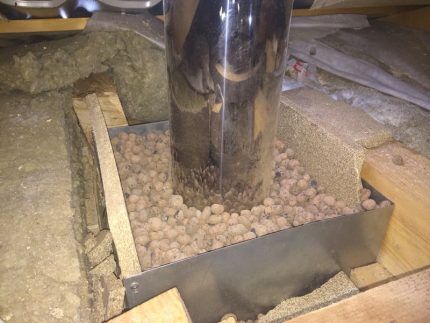
Where the box comes into contact with the roof or sheathing, it is necessary to install protection from steel sheets to prevent fire.
Insulation of a brick chimney
A brick chimney is traditionally insulated by plastering with preliminary fastening of the reinforcing mesh. The advantages of this method are low cost, the disadvantages are low efficiency. Heat losses are reduced by no more than a quarter.
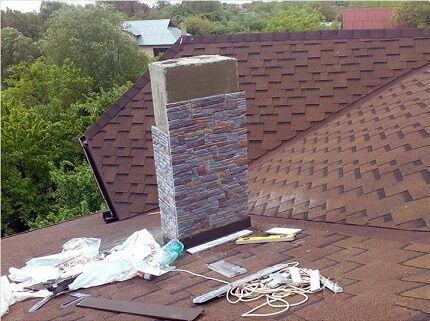
You can increase the efficiency of insulation of a brick chimney using mineral wool mats.
The insulation must fit tightly to the plastered chimney, this way the appearance of cold bridges is eliminated.Taking into account the fact that mineral wool easily absorbs moisture, it must be covered with a layer of vapor barrier film and then secured with construction tape.
Conclusions and useful video on the topic
Insulation of a steel gas chimney:
To ensure high-quality removal of gases generated as a result of combustion, insulation of the chimney pipe is a vital necessity. Mineral wool is considered the ideal insulation material; it is this material that meets all the requirements for high-quality and reliable insulation.
Purchasing ready-made insulated modules will help speed up installation work. But you can carry out insulation yourself with basalt wool, and get an analogue of a sandwich pipe at a lower cost. The use of cylinders and shells made of mineral wool can significantly speed up the process of chimney insulation.
Would you like to share your own experience in thermal insulation of a gas boiler pipe? Do you have useful information that will be useful to site visitors? Please write comments in the block form below, ask questions, post photos on the topic of the article.
